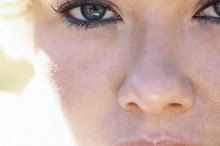Why Does My Nose Turn Red?
Although a red nose may look jolly on Santa Claus, the average person doesn’t want one. A number of things can cause a red nose, but you can generally counteract it with various treatments or neutralize it with makeup.
If you are experiencing serious medical symptoms, seek emergency treatment immediately.
Common Causes
Cold temperatures, emotional stress and oversensitive blood vessels can redden your nose, as can wind, spicy food, skin disorders, alcohol consumption and exercise. Over-washing your skin may also cause a red nose as can irritation of the nasal skin due to a runny or stuffy nose or allergies.
Medical Causes
What Are the Causes of a Red Nose?
Learn More
Persistent redness of the nose can be a sign of rosacea, which affects about 5 percent of the population. Rosacea can also affect the forehead, cheeks and chin. Oversensitive blood vessels are another cause of a red nose, particularly in smokers or people with thyroid disorders.
- Persistent redness of the nose can be a sign of rosacea, which affects about 5 percent of the population.
- Oversensitive blood vessels are another cause of a red nose, particularly in smokers or people with thyroid disorders.
Reason
Generally, irritants and other agents cause the blood vessels in the nose to dilate, bringing blood to the surface and creating a rosy hue.
Treatment
Why Does My Face Turn Bright Red When I Exercise?
Learn More
Treatment depends on the cause. If cold is the culprit, keep your nose covered while outside and warm it with a warm compress when you return inside. If the cause is over-washing, use tepid water and wash very gently. You can combat redness caused by emotional stress with deep breathing and relaxation. Quitting smoking can also help. Your doctor can prescribe medication if the cause is rosacea.
- Treatment depends on the cause.
- Your doctor can prescribe medication if the cause is rosacea.
Camouflage
If you can't cure the redness and need to hide it, cover it with green makeup you can purchase over the counter. The green color neutralizes the redness in the skin.
Related Articles
References
- Sforza C, Grandi G, De Menezes M, Tartaglia G, Ferrario V. Age- and sex-related changes in the normal human external nose. Forensic Sci Int. 2011;204(1-3):205.e1-205.e9. doi:10.1016/j.forsciint.2010.07.027
- Sharma P, Arora A, Valiathan A. Age changes of jaws and soft tissue profile. ScientificWorldJournal. 2014;2014:301501. doi: 10.1155/2014/301501
- Lee JW, McHugh J, Kim JC, Baker SR, Moyer JS. Age-Related Histologic Changes in Human Nasal Cartilage. JAMA Facial Plast Surg. 2013;15(4):256-262. doi:10.1001/jamafacial.2013.825
- Feng Wen Y, Ming Wong H, McGrath CP. A longitudinal study of facial growth of Southern Chinese in Hong Kong: Comprehensive photogrammetric analyses. PLoS One. 2017; 12(10): e0186598. doi: 10.1371/journal.pone.0186598
- Sforza, Chiarella, Grandi, Gaia, De Menezes, Marcio, Tartaglia, Gianluca M and Ferrario, Virgilio F. Age- and Sex-Related Changes in the Normal Human External Nose. Forensic Science International. Vol 204, Issue 1-3, pp. 205.e1-205.e9
- van der Heijden P, Korsten-Meijer AG, van der Laan BF, Wit HP, Goorhuis-Brouwer SM. Nasal growth and maturation age in adolescents: a systematic review. Arch Otolaryngol Head Neck Surg. 2008 Dec;134(12):1288-93. doi: 10.1001/archoto.2008.501
Writer Bio
Alana Grelyak is a writer and musician living in Chicago, Illinois. Grelyak earned a Master's Degree in music from the University of Wisconsin, and has written on the topics of entertainment, restaurants, music, telecommunications, and more. Her work has appeared in numerous places, including Punchline, Lumino Magazine, Time Out Chicago, Midwest Beat, Pipeline, and others.









